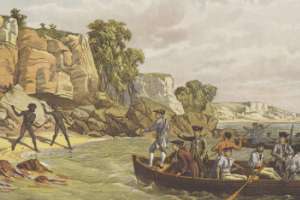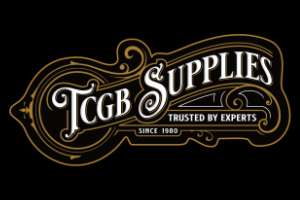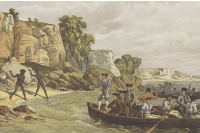
A lithograph depicting Indigenous Australians and the arrival of Cook and his crew, titled "Captain Cook's Landing at Botany, AD 1770".CREDIT:NATIONAL LIBRARY OF AUSTRALIA
Captain Cook finds tattooing in the South Sea's
King George III of England, on the recommendation of the royal society, gave his blessings to an expedition to Tahiti to observe and record the transit of the planet Venus, which was due to pass between the earth and the sun on June the 3rd 1769.
The Island of Tahiti in the South Pacific was chosen, for it was believed to be the best place the transit could be observed. The Royal Society had the person who they wanted to lead the expedition and he was Alexander Dalrymple (1737-1808) the renowned geographer and astronomer. But due to his lack of seafaring knowledge and as he was not a naval officer the lords of the admiralty would not consider him for the post, preferring instead to give the command to a 40-year-old James Cook (1728-1779) making him a lieutenant in the process.
The ship chosen for the voyage was formerly the Earl of Pembroke, a 368-ton vessel, which was a heavy but small ship. And after a refit and a name change she became the ‘HMS Bark Endeavour’ and when she set sail from Plymouth, England on the 26th of August 1768 she had 94 men on board and provisions for 18 months. For it was decided by the admiralty that Cook would combine the observation of Venus with the voyage of discovery to the unknown Islands of the South Seas, and on the 13th of April 1769 King George Island (later known as Tahiti) saw Cook and a crew party land on the Island.
And little did Cook or the admiralty back home in England know that when they commissioned the voyage they would unknowingly rekindle the art and passion of pricking (formerly the name for tattooing), and restarting the tradition of sailors the world over. But contrary to popular belief it was not Cook who reintroduced the word tattoo (from the Polynesian word tattow) back into the English language as a means of marking the skin. It was Joseph Banks (1743-1820) (later Sir Joseph) who first recorded the name and customs of the people who wore the marks, and it was his observations that secured tattooing’s place back into British history.
In his journals Banks described the designs, the application and he also went into detail on how he was truly mystified why the people of Tahiti put themselves through so much pain. He also found that the body makings were performed on the natives between the ages 14 and 18.
Now with the transit of Venus having been observed, it was time for the Endeavour to set sail on possibly her greatest voyage. The date being the 13th of July 1769 and it was on this day that Cook told his crew of the secret orders of the admiralty and that they were not to return home straight away. And on the 7th of October 1769 the unexplored East Coast of New Zealand was reached, and two days later Cook went ashore with a party of men.
Before this in 1642, Dutch navigator Abel Janszoon Tasman (1603-1659) first sighted New Zealand, but Tasman’s expedition comprising of two ships the Heemskirk and the Zeehaen didn’t land on the newly found Island because the natives who quickly surrounded the now anchored ships seemed far to fierce and indeed four men were killed when a boat from the Zeehaen was dispatched to land – and was rammed by the Maoris. This shocked Tasman so much that he didn’t bother to try another landing on the Island in which he named Murderers Bay.
This also at first proved a problem for Cook and his men when they landed on New Zealand when four of the Islanders ran at them with long clubs, which saw one of Cooks men to fire a shot over their heads. But this did not stop them so a second then third shot was fired killing one of the attackers, which prompted the others to retreat. The next day a Tahitian chief called Tupia, who had travelled from his home with the ship, approached the Maoris who could understand his speech and persuaded them that Cook and his men meant no harm, but more trouble flared and three more of the Maoris were killed. So with this Cook decided to turn north, and for the next six months he charted the coast and discovered that New Zealand was two Islands and not part of a larger land mass.
Also on this voyage were the men that in the days of no photography had the job of recording what had been seen via paintings and drawings. There were two artists on the trip, one being Alexander Buchan (d-1769) the second Sydney Parkinson (1745-1771). Buchan was a landscape painter and his task was to paint the places, which had been visited. But arguably Parkinson had the more important role in drawing wild life and specimens that were found.
Meanwhile Banks was busy writing in his journals, and he noted the tattoos of the people, and he wrote of the facial marks that seemed to have a channeled look. He also noted a broad spiral on the buttocks was quite common and that the women seemed to mark their lips black. Banks was most impressed with the Moko (facial tattoo) and how it gave the Maori a more frightening appearance, and although Banks thought the markings were ugly he admired the elegance of them.
Banks became so fascinated by what he had seen, and to go along with his scientific nature he found that he was to become the first Englishman to come into the ownership of a preserved Maori tattooed head. When on the 15th of January 1770, four Maori heads were brought onto Cook’s ship when she was moored at Queen Charlotte Sound. And on the 19th of January 1770, Banks purchased one. Hence starting the activity in the buying or trading of Mokoed heads from decapitated bodies.
Banks picked the head from a batch of four that were brought to the ship Endeavour for the naturalist to inspect, and the head he chose was that of a young man of 14 to 15 years old. The other heads were not required.
Also during this time Sydney Parkinson did many drawings of the natives with tattoos and he also made diagrams of the instruments that were used to tattoo the people, and in his papers that were published in 1773 he went into great detail of the tattooing and probably more in-depth then Banks account, for Parkinson even had some tattoos put upon himself. So he did have a first hand knowledge of the art. Today Sydney Parkinson’s drawings can be seen at the British museum London, England.
Copyright…Paul Sayce
Posted on 16th April 2009



